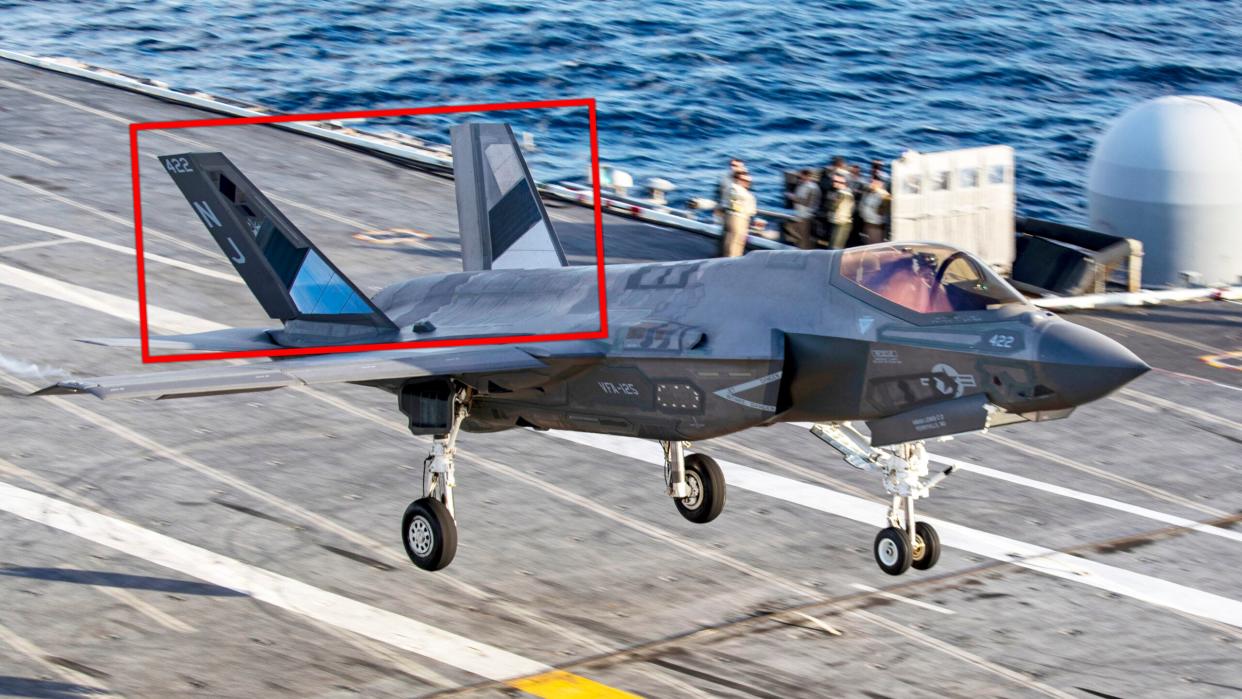F-35C With Mirror-Like Coating Photographed Aboard Carrier

The sudden arrival of mirror-like coatings on all of America's stealthy tactical jets (F-22, F-35, F-117) definitely grabbed a lot of interest starting in late 2021 and appeared repeatedly through 2022 in various forms. But all the known instances of combat aircraft receiving these exotic treatments, which are thought to decrease the signature of the aircraft, most likely in the infrared spectrum, have been on examples flying for testing purposes, although the concept dates back decades. Now, one F-35C that was operating aboard the USS Abraham Lincoln off the California coast has appeared this week with similar coatings.
The photos of the jet in question were published by the Defense Department and show the F-35C doing a touch-and-go aboard the carrier. Two things are quite intriguing about the F-35C being shown. First is the multi-toned mirror-like treatment applied to the outside and inside of its vertical tails. The installations on each tail are made up of patches of dark and shiny sheet and tile-like coatings. Similar coating has been shown to change dramatically based on the angle of view, going from opaque to transparent, and in some cases, from shiny to dark, based on where the viewer is looking at it from. The upper wings also appear to have strips of the same roughly three types of coatings we have seen on other stealthy aircraft.

What's most interesting is the unit the F-35C belongs to — VFA-125, the "Rough Raiders." This squadron serves as the Fleet Replenishment Squadron (FRS) for the F-35C. Based out of NAS Lemoore, it trains Navy and Marine crews on how to operate the 'big wing' navalized Joint Strike Fighter. In other words, it is not a test squadron and it is not a frontline squadron. Why one of its F-35Cs would be adorned with this technology is unclear at this time.

We could be seeing VFA-125 jets being used as part of a larger test initiative for these coatings. This would make some sense as the squadron has aircraft that are not tasked to deployable units that are based locally in California, near major parts of the test and evaluation aviation enterprise for the Navy, namely NAWS China Lake. Just seeing how the coatings wear over time while serving with a unit with a heavy operational tempo could be data worth collecting. On the other hand, more aircraft with more configurations of the material could be required for larger test events. VFA-125 acting as a source of those aircraft and 'borrowed' as needed while not disrupting their critical training mission could make sense.

On the other hand, we could see the early signs that this coating is going to be headed to the fleet, even in a limted manner. Why the training squadron would receive it first is puzzling though and this jet appears to have all three types of coatings on it at once, which points to comparative testing.
It's worth noting that the other aircraft seen on the carrier in the photos are the counterparts of VFA-125, being training squadrons for their respective types. They include the VFA-122 "Flying Eagles," also based in Lemoore, covering west coast F/A-18E/F Super Hornet FRS duties and VAQ-129 "Vikings" providing a similar service at NAS Whidbey Island for the EA-18G Growler community. One could assume the aircraft were using the vessel for carrier qualification work.

So we have a bit of a mystery on our hands, but if these coatings, or at least one of them, migrate from the testing environment to the fleet, we will likely learn more about them. If anything, these images show that the Navy appears to be still interested in what they can provide.
A big thanks to @space_osint for the heads up on the photos!
Contact the author: Tyler@thedrive.com

